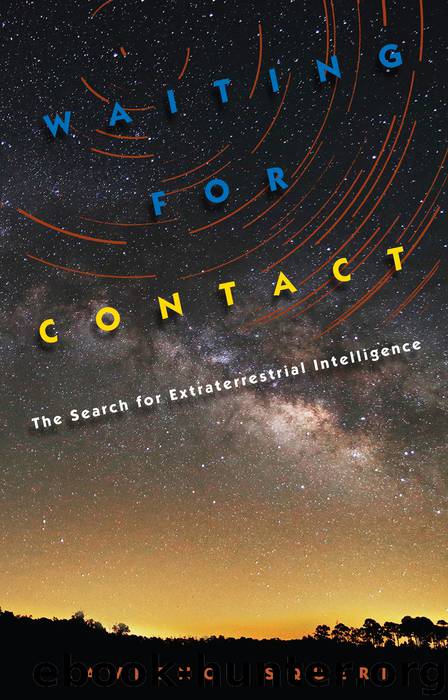Waiting for Contact by Squeri Lawrence;

Author:Squeri, Lawrence;
Language: eng
Format: epub
Publisher: University Press of Florida
Published: 2016-02-28T16:00:00+00:00
NASA’s SETI Workshops
Ohio State’s SETI search was grassroots initiative, the world’s first continuous SETI program, but Drake, Morrison, and Billingham had something grander in mind. “Big science” had defined their professional careers. Morrison had worked on the Manhattan Project during World War II; Billingham was a NASA administrator during the glory days of the Apollo missions; in the late 1960s, Drake was directing the Arecibo Observatory. All three envisioned SETI as a major government project. Yet by 1975 the Project Cyclops fiasco was reducing SETI’s chances of NASA approval.
The time had come for Billingham to resell SETI within NASA. He realized that his first task was gaining “the support of the scientific community.” Without that, SETI was “dead in the water.” He assembled six SETI workshops, which Morrison consented to chair. Billingham later described these workshops as “the best decision” he “ever made.”39
The workshops met from January 1975 to June 1976 under the auspices of NASA’s Ames Research Center.40 Sixteen leading scientists, in tandem with NASA people from Ames, scientists from Caltech’s Jet Propulsion Laboratory in Pasadena, and others from NASA headquarters, discussed SETI. Their favorable assessment was no surprise, for Billingham had stacked the deck with SETI backers. Morrison, Drake, Sagan, Oliver, Bracewell, Greenstein, and A. G. W. Cameron were among the sixteen scientists running workshops. Also participating was Joshua Lederberg (1925–2008), biologist and Nobel laureate in medicine. Lederberg was very much interested in possible alien life, even the lowliest bacteria. Another participant was Charles Townes, a veteran of the 1971 Byurakan II conference. The rest were mostly astronomy professors.
The workshops broke no new ground. Their purpose was to repeat and validate the SETI narrative, but NASA published their report, thereby adding government approval of sorts to the speculations of SETI true believers. As could be expected, the workshops pointed out that scientists could learn much from extraterrestrials. The workshops also took the long view. It assumed older extraterrestrial races had faced many travails similar to those of Earth’s twentieth century. With luck, the trajectories of older civilizations might give humanity deep insights into the direction of its own history, perhaps regarding the very meaning of the human journey, and whether and how evolution ends.
The workshops carefully projected a big-tent appeal. They noted that engineers and scientists would not be the sole beneficiaries of extraterrestrial knowledge. A wide range of professionals. “Anthropologists, artists, lawyers, politicians, philosophers, theologians”—in fact, “all thoughtful persons, whether specialists or not,” stood to gain.
The workshops defined SETI as a win-win undertaking, for even failed searches carry a positive outcome. A universe found empty of intelligent life would give humanity “a strengthened belief in [its] near uniqueness.” Besides, technology developed for SETI had other applications. As for potential dangers, SETI telescopes would listen but not transmit. Earth can choose to ignore an offensive message; the other civilization will never know of humanity’s existence. The dangers are few, but the benefits are many, the workshops declared.
As always, the bottom line was money. Would a SETI program be expensive? With NASA budget hawks in mind, the workshops’ answer was a simple no.
Download
This site does not store any files on its server. We only index and link to content provided by other sites. Please contact the content providers to delete copyright contents if any and email us, we'll remove relevant links or contents immediately.
| Aerodynamics | Aircraft Design & Construction |
| Astronautics & Space Flight | Avionics |
| Gas Dynamics | Propulsion Technology |
Whiskies Galore by Ian Buxton(41524)
Introduction to Aircraft Design (Cambridge Aerospace Series) by John P. Fielding(32882)
Small Unmanned Fixed-wing Aircraft Design by Andrew J. Keane Andras Sobester James P. Scanlan & András Sóbester & James P. Scanlan(32569)
Craft Beer for the Homebrewer by Michael Agnew(17927)
Turbulence by E. J. Noyes(7690)
The Complete Stick Figure Physics Tutorials by Allen Sarah(7135)
Kaplan MCAT General Chemistry Review by Kaplan(6587)
The Thirst by Nesbo Jo(6432)
Bad Blood by John Carreyrou(6270)
Modelling of Convective Heat and Mass Transfer in Rotating Flows by Igor V. Shevchuk(6219)
Learning SQL by Alan Beaulieu(6027)
Weapons of Math Destruction by Cathy O'Neil(5820)
Man-made Catastrophes and Risk Information Concealment by Dmitry Chernov & Didier Sornette(5641)
Digital Minimalism by Cal Newport;(5384)
Life 3.0: Being Human in the Age of Artificial Intelligence by Tegmark Max(5181)
iGen by Jean M. Twenge(5151)
Secrets of Antigravity Propulsion: Tesla, UFOs, and Classified Aerospace Technology by Ph.D. Paul A. Laviolette(4974)
Design of Trajectory Optimization Approach for Space Maneuver Vehicle Skip Entry Problems by Runqi Chai & Al Savvaris & Antonios Tsourdos & Senchun Chai(4837)
Electronic Devices & Circuits by Jacob Millman & Christos C. Halkias(4739)
